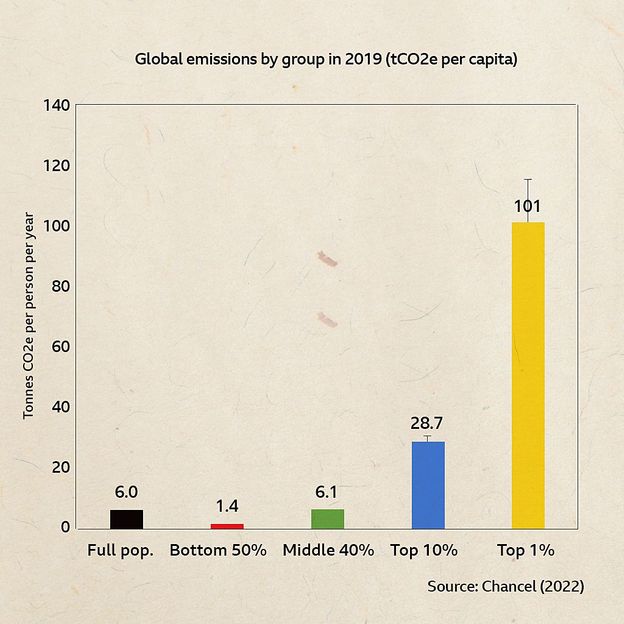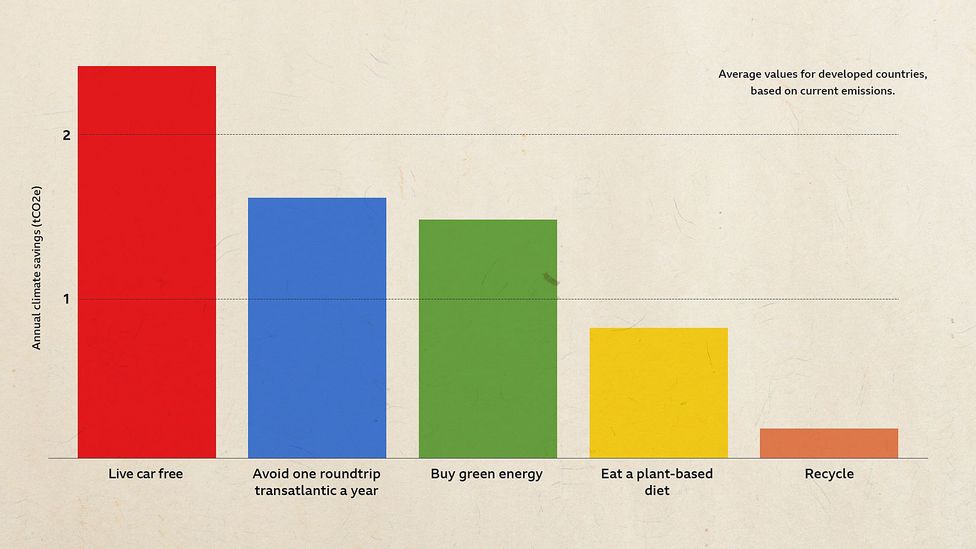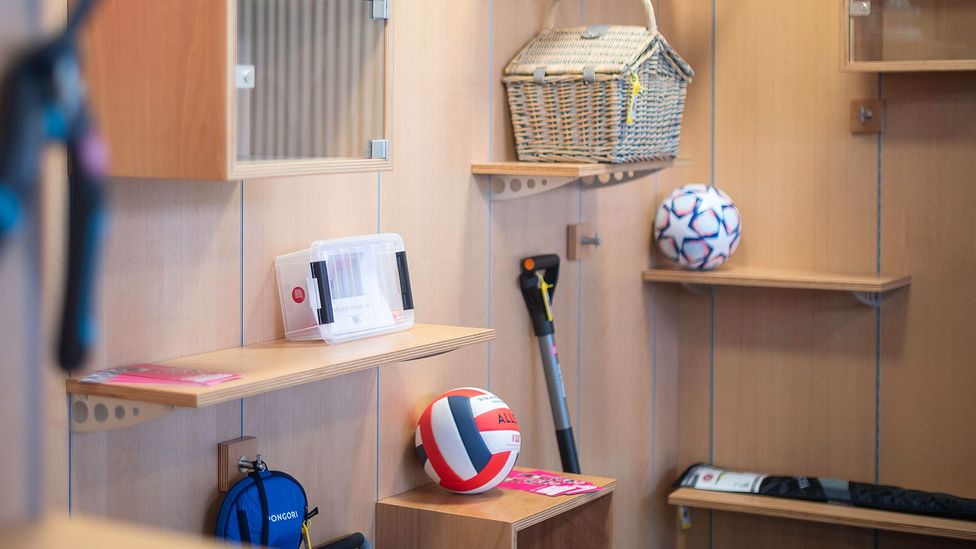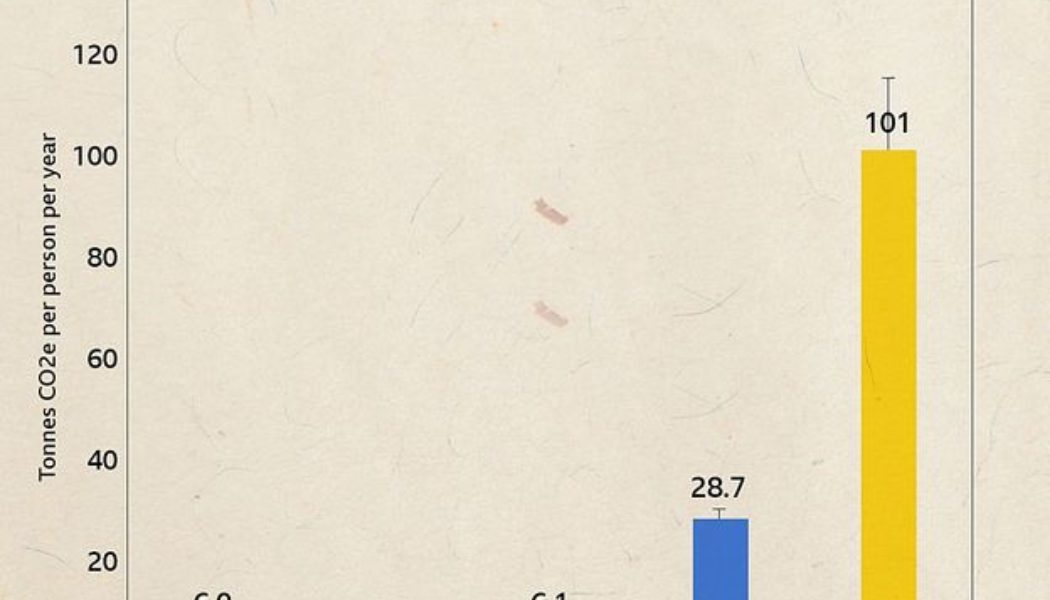As 2020 drew to a close, Carys Mainprize set herself a challenge for the approaching year: to spend the next 12 months living on two tonnes of carbon: an amount equivalent to around half the average yearly emissions of a petrol car in the US.
It was not an easy challenge. Mainprize lives in the UK, where the average yearly consumption footprint per person is over four times her goal: 8.5 tonnes of carbon dioxide equivalent (CO2e), a measure that includes CO2, methane and other greenhouse gases.
Mainprize, a communications officer at a climate non-profit, began researching the carbon footprints of everything she could. She wanted to see what it would take – and indeed if it was possible – to live in the UK on a personal carbon allowance that’s roughly similar to what we will all need to reach in the next decade to avoid the worst impacts of climate change.
Surveys show that many people want to participate in climate actions, but putting a very low-carbon life into practice can mean be tricky: it can mean changing several aspects of daily life, particularly for the richer parts of society.

The top 1% of emitters globally each emit an average 101 tCO2e per year, while the bottom 50% emit just 1.4 tCO2 each. Source: Chancel (2022) (Credit: BBC)
But experiments like Mainprize’s could help to show the rest of us the way ahead on what a sustainable society could really look like – and the wider-scale changes we need to get there.
So what would the world look like if those of us who currently emit far more did manage to reduce our emissions to a safer level?
A challenging climate
In some ways two tonnes is an arbitrary figure. After some research, Mainprize decided it would be a decently ambitious target to go for. In his book about carbon footprints, How Bad Are Bananas, researcher Mike Berners-Lee suggests readers might want to aim for a five tonne lifestyle for now, which he notes would already be “a big step forward” for most in the UK.
In some higher-emitting countries even this may be difficult – in the US, Canada and Australia, for example, per capita emissions sit at 16-17 tonnes of CO2e a year.
A report in 2021 from Oxfam found that by 2030 the global average emissions need to sit at just 2.3 tonnes of CO2 per year to keep global warming below 1.5C (the report didn’t cover other greenhouse gases), down from 4.6 tonnes on average globally today.
“What we’re showing is that there are currently some global income groups who are far in excess of [the target of 2.3 tonnes],” says Tim Gore, head of the climate and circular economy programme at the Institute for European Environmental Policy, a sustainability thinktank, and author of the Oxfam report. “Some, at least 50% of the global population, are currently below that level and will still be below that level by 2030.”

Research shows some personal choices can have a particularly big impact on cutting your carbon footprint. Source: Wynes & Nicholas (2017), (Credit: BBC)
Another report from the Hot and Cool Institute, a Berlin-based think tank, estimated that by 2040, per capita lifestyle emissions need to be 1.4 tonnes of CO2e and by 2050, just 0.7 tonnes CO2e.
In 2019, when London-based activist Rosalind Readhead decided to try to live on just one tonne of carbon for a year, she based her challenge on this report. “That report meant so much to me, because I finally had a scientific foundation on which to do a project such as the one tonne project,” she says.
Readhead rounded the 0.7 tonnes target to one tonne in part as an acknowledgement that it’s difficult to live a low-carbon life with our current infrastructure.
Such struggles highlight the systemic nature at the heart of the climate problem: it’s very hard to live on little carbon if the products, society and infrastructure around you are all high-emitting. In fact, few argue people should be getting to these kinds of levels with individual action alone: much of the products, infrastructure, systems and political decisions which affect all our lives also need to change to reduce emissions.
While trying to live on two tonnes of carbon, Mainprize found herself confronted with several examples of this. She lacked power over the insulation in her home, which she rents, and there was no requirement for her landlord to install this. She was also reliant on a car for work and found buying an electric car too expensive.
“It is clear that individuals in their variety of social roles can contribute significantly in emissions reduction,” says Joyashree Roy, professor of economics at Jadavpur University in Kolkata, India. But unless they are supported by the right infrastruture, technology and policy incentives, she says, this cannot achieve its full potential. For example, “how can an individual walk in a city which does not provide safe, nice walkable paths?”
Still, there can be a false dichotomy in discussions about individual behavioural change versus systems change, says Lewis Akenji, managing director of the Hot or Cool Institute.
“[We need] both individual and systems change,” says Akenji: government policy, societal preferences and consumer behaviour can all influence each other.
A two-tonne world?
According to the Intergovernmental Panel on Climate Change (IPCC), with the right policies, infrastructure and technology in place to enable changes to our lifestyles and behaviour, we can reduce overall greenhouse gas emissions substantially by 2050. The IPCC also says the world needs to reach net zero emissions with limited overshoot by 2050 to keep global warming below 1.5C.
In richer countries, this means moving towards a far lower carbon lifestyle for most people. But the changes to get there aren’t necessarily painful or even negative. For example, research has shown that good public services enable higher wellbeing at lower energy use.
One major change would be to change how we move around. Akenji envisions a combination of public transport alongside micro-mobility systems (such as electric scooters and drones) which make it efficient and effective for people to reach it. Private cars, with their huge emissions and often empty seats, would largely be a thing of the past, he says, and car parks converted to green public spaces where people go to play, relax or do exercise.
This high-quality public transport would be electrified and powered by renewable sources, says Gore. It would be complemented by cycling and walking and other forms of mobility that get people active – benefiting wellbeing and health too.

Moving to public transport, walking or biking can hugely cut personal carbon emissions, but can be tricky if the right infrastructure isn’t yet in place around you (Credit: Alamy)
This would entail huge changes to urban planning in many places around the world which are designed for private cars, notes Gore. It could also mean a comeback for local high streets and markets where people could shop on foot or by bicycle. There would also be a substantial reduction in flying, he adds, with longer distance travel provided instead by the expansion of high-speed rail and night train services. (Read more about what a flying-free world would look like.)
Housing, meanwhile, is among the lowest hanging fruit for cutting carbon, says Gore, so huge changes would be quickly seen in a drive towards a two-tonne-per-person world, starting with a huge scale-up of energy efficiency renovations in homes. “We’d save every household money while lowering our emissions, and probably create a lot of jobs for people doing that renovation in the process, and add to the value of people’s housing assets,” says Gore. “It’s a no brainer.”
The International Energy Agency (IEA) has argued that well targeted public spending to support insulation and other kinds of energy efficiency could go a long way to cutting carbon. In her effort to live on one tonne of carbon a year, Readhead realised that turning on her gas boiler for just 45 minutes ate up her entire daily budget of carbon. When she later installed secondary glazing on her windows, however, she found she hardly had to put the heating on at all.
Thinking of hot weather, meanwhile, all new homes would be also redesigned allow good level of comfort in warm places and minimise their air conditioning requirements, says Lucas Chancel, an economist at the Paris School of Economics.
Food and things
Another large-scale change in a two-tonne world would be to our diets – especially moving to plant-based diets, says Julia Steinberger, professor of ecological economics at the University of Lausanne in Switzerland. “These are often cheaper as well. They require a bit of experimentation and a learning curve – cooking based on lentils, beans, tofu and other forms of plant protein, rather than meat or dairy – but are achievable by all.” (Read more about the lowest carbon sources of protein).
Meat and dairy products would be seen more as a luxury or a special occasion treat rather than something you would eat two or three times a day, says Gore.

Moving to a more plant-based diet is one of the biggest ways to cut your personal carbon emissions, but some people find cutting out meat altogether tricky (Credit: Getty Images)
A major 2019 report looking at the “planetary health diet” aimed to set out the optimal diet for balancing both healthy people and the planet. It recommended meals should consist of around half a plate of fruit vegetables and plenty of legumes and nuts. Vegan and vegetarian diets can help meet these requirements, it said, but some meat and dairy can still be incorporated.
Diet is also a particularly personal thing for people. In her two-tonne experiment, Mainprize, already a vegetarian, found cutting out milk and cheese fairly doable. In contrast, Readhead found herself struggling to completely abolish meat from her diet, especially through the colder winter months when she did eat the odd meal with lower carbon meats, such as chicken and venison.
And then there are our other types of consumption. “[A low-carbon world] is a world where overall we consume less of ‘stuff’,” says Chancel. We might consume more cultural experiences (think festivals, theatre trips or dance classes), but “in terms of stuff, whatever has a weight, whatever is produced with matter and with energy, we consume less of that”, he says.
This is not some plan to get rid of all our electronics and clothes, but it is a world where their production is based on renewable electricity not fossil fuels, where better quality, longer lasting products rule and where we simply buy fewer of them. It also means a far higher focus on repairability and recycling, says Gore – rather than buying a new phone every year or so.

At the ‘Library of Things’ in Sachsenhausen Library Centre, people can borrow objects they might otherwise need to buy (Credit: Alamy)
The European Union has already adopted a “right to repair” on consumer products which aims to ensure more products are repaired within the legal guarantee and provide people with better options to repair products that are technically repairable, even if they are outside the guarantee. Measures like this can help to start to build a “repair economy” by requiring companies to make their products repairable and make manuals and spare parts available at an accessible price, says Gore.
While people would still travel for holidays, meanwhile, they would generally become more local, more deliberate, and less consumptive, says Akenji. “Quite often the things that we consider holidays are more just opportunities for consumption – and they do not necessarily improve our wellbeing,” he says. “What really improves our wellbeing is getting off the work mindset for a bit to recharge, engaging with communities and people that you love, or discovering other things you do not typically do not engage with.”
Work itself may also change in a low-carbon world. Work contracts could look different than todays, with an increasing focus on working from home and shorter and more flexible hours. Still, there would be plenty of work to do in a low-carbon world – one recent report estimated the shift to a green economycould create 18 million jobs.
But it wouldn’t necessarily mean a lower standard or living or wellbeing for people in richer countries. Research has shown that the use of energy and carbon past a certain level does not necessarily mean higher living standards.
“A small amount of energy-emissions matters a lot [to wellbeing] at low levels, at higher levels it no longer does,” notes Steinberger, who co-authored the research. In some areas of the world, of course, energy use and per capita emissions should rightly increase. The idea that higher emitting, richer countries should lower their emissions to allow for this is often referred to as the need to give them their fair “carbon space“.

Rosalind Readhead found herself seeking out ‘carbon freebies’ – low-carbon activities she loves to do – to help her live a low-carbon life (Credit: Rosalind Readhead)
In her efforts to live on one tonne of carbon in today’s world, Readhead found herself seeking out what she calls “carbon freebies”: carbon-free activities that she loved to do.
“You can meditate, be in nature, just stop doing things and absorb the world, smell flowers, go foraging, art, walking, cycling, gardening,” she says. “Listening or playing acoustic music, singing, dancing, all the things we did as kids: these are things that we had a great love of.”
Carbon Count
The emissions from travel it took to report this story were 0kg CO2. The digital emissions from this story are an estimated 1.2g to 3.6g CO2 per page view. Find out more about how we calculated this figure here.
She found that memories of a life before phones and computers started to come back to her. “Just sitting around with friends chatting,” she says. “Just having a lark.”
And did Mainprize and Readhead meet their respective goals? In the end, Mainprize accidentally lost the spreadsheet she was using to track her carbon around month seven, but up until then thinks she was “just under the monthly average of the total where I should be”. She notes, though, that there were some things she bought – like an electric blanket – that she couldn’t find the carbon footprint of, so weren’t included.
Readhead also thinks she managed to reach her one tonne target – but says she couldn’t have gone lower: “I needed all that carbon.”
Akenji says he feels inspired by people like Readhead and Mainprize who are actually trying out and testing how to live sustainably.
“Although it might be hard for them to come within that threshold, what they’re actually doing is informing us on the kind of changes that we need to make, in the future, to make it easier and the default to live a one-tonne life.”
* Jocelyn Timperley is a senior journalist for BBC Future. Find her on Twitter @jloistf
—
Join one million Future fans by liking us on Facebook, or follow us on Twitter or Instagram.
If you liked this story, sign up for the weekly bbc.com features newsletter, called “The Essential List” – a handpicked selection of stories from BBC Future, Culture, Worklife, Travel and Reel delivered to your inbox every Friday.









